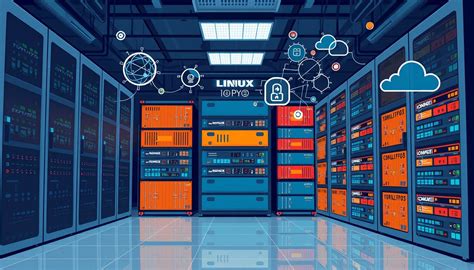In the rapidly evolving landscape of modern IT infrastructure, the ability to maximize resource efficiency and streamline deployment processes is paramount. This is where containerization emerges as a transformative technology, fundamentally altering how applications are developed, deployed, and managed. Far more than just a buzzword, containerization offers a powerful solution for optimizing server usage, enhancing scalability, and accelerating the entire software development lifecycle. For organizations grappling with complex environments and the constant demand for faster, more reliable application delivery, understanding and implementing effective containerization strategies is no longer optional; it’s a strategic imperative. This comprehensive guide will delve deep into the core concepts of containerization, explore its myriad benefits for server optimization, discuss key technologies and best practices, and examine how this paradigm shift is redefining IT efficiency and driving significant operational advantages. Content focused on such critical technological advancements often garners high engagement, making it highly valuable for SEO and maximizing Google AdSense revenue.
Containerization: The New Standard
At its essence, containerization is a lightweight, portable, and self-sufficient method of packaging software and its dependencies into a single, isolated unit called a container. Unlike traditional virtual machines (VMs), which virtualize the entire hardware stack and include a full operating system for each application, containers share the host operating system’s kernel. This fundamental difference makes containers significantly more efficient, agile, and resource-friendly.
Imagine shipping goods. A virtual machine is like shipping a house, complete with its own foundation, plumbing, and electricity, even if you only need a single room. A container, on the other hand, is like shipping just that single room, pre-fabricated and ready to be placed on any existing foundation (the host OS). This distinction is crucial for understanding its impact on server usage.
Key characteristics that define containerization include:
- Isolation: Each container runs in its own isolated environment, ensuring that applications and their dependencies do not interfere with each other. This prevents “dependency hell” and conflicts between different applications on the same server.
- Portability: Containers are designed to run consistently across various computing environments—from a developer’s laptop to a testing server, production data center, or public cloud. This “build once, run anywhere” philosophy eliminates compatibility issues.
- Lightweight Nature: Because containers share the host OS kernel and only package the application and its specific libraries/dependencies, they are much smaller and start up far more quickly than VMs. This reduced overhead is a cornerstone of server optimization.
- Consistency: The container encapsulates everything an application needs to run, ensuring it behaves identically regardless of where it’s deployed. This consistency drastically reduces “it worked on my machine” problems.
- Efficiency: Containers enable multiple isolated applications to run on a single host with minimal overhead, leading to higher server utilization and reduced infrastructure costs.
The most prominent technology driving the container revolution is Docker, which popularized the concept and provided the tooling to build, ship, and run containers. Beyond Docker, orchestration platforms like Kubernetes are essential for managing large-scale container deployments, making them truly enterprise-ready.
How Containerization Optimizes Server Usage
The efficiency gains from containerization are manifold and directly translate into optimized server usage and significant cost savings. Let’s break down the core mechanisms.
A. Reduced Overhead and Resource Footprint
Traditional virtualization (VMs) involves a hypervisor managing multiple guest operating systems. Each VM carries the overhead of its own operating system (OS) kernel, drivers, and libraries, even if applications within them are small. This consumes significant CPU, RAM, and storage resources.
- Shared OS Kernel: Containers eliminate the need for a separate guest OS for each application. Instead, all containers running on a host share the same underlying host OS kernel. This drastically reduces the resource footprint per application.
- Minimal Runtime: A container only includes the application code and the specific libraries/dependencies it needs. It doesn’t carry the weight of an entire operating system. This makes containers incredibly lightweight, typically in megabytes rather than gigabytes for VMs.
- Faster Startup Times: Due to their lightweight nature, containers can start up in seconds, or even milliseconds, compared to minutes for VMs. This agility allows for more efficient scaling and resource allocation on demand.
The combined effect of these factors means you can run significantly more applications on a single physical or virtual server using containers than you could with traditional VMs or bare-metal deployments, leading directly to higher server utilization.
B. Enhanced Resource Isolation and Allocation
While containers share the kernel, they provide strong isolation at the process level. This means applications within separate containers cannot directly interfere with each other.
- Resource Limits (CPU, RAM): Container orchestration platforms (like Kubernetes) allow administrators to define precise CPU and memory limits for each container. This prevents a single misbehaving application from hogging all server resources and impacting other services running on the same host.
- Guaranteed Resources: You can also set resource requests, ensuring a container gets a minimum amount of resources it needs to function effectively. This predictability improves application performance and stability.
- Efficient Scheduling: Orchestrators can intelligently place containers on servers across a cluster, considering available resources and defined limits, ensuring optimal load distribution and maximizing server capacity. This means less idle server capacity.
This granular control over resource allocation ensures that server capacity is used efficiently, preventing resource contention and allowing for more predictable performance across multiple applications sharing the same hardware.
C. Improved Density and Consolidation
The lightweight nature and efficient resource management of containers directly translate into higher application density on servers.
- Running More Applications per Server: Businesses can deploy many more containerized applications on a single server than they could with VMs, leading to better utilization of their existing hardware.
- Reduced Server Count: This increased density means fewer physical or virtual servers are needed to run the same number of applications. This directly translates to lower hardware procurement costs, reduced power consumption, less rack space, and decreased cooling requirements.
- Lower Infrastructure Costs: Fewer servers mean less capital expenditure (CapEx) on hardware and reduced operational expenditure (OpEx) on power, cooling, and maintenance. This is a significant factor for companies looking to optimize their IT budget.
D. Faster Deployment and Scaling
The agility of containers significantly impacts server usage by enabling dynamic scaling.
- Rapid Provisioning: Containers can be instantiated in seconds, making it incredibly fast to spin up new application instances to meet demand.
- Horizontal Scaling: When application load increases, new container instances can be quickly added across existing servers or on newly provisioned ones. When demand subsides, containers can be just as quickly removed, freeing up resources. This elasticity ensures resources are only consumed when needed.
- Reduced Idle Resources: Unlike VMs, which might remain running even if their application load is low, containers allow for more fine-grained scaling down, reducing wasted server capacity during off-peak times.
- Automated Orchestration: Tools like Kubernetes automate the deployment, scaling, and management of containers, ensuring optimal server usage without manual intervention.
This dynamic scaling capability ensures that server resources are utilized precisely when and where they are needed, eliminating the waste associated with over-provisioning servers to handle peak loads.
Key Technologies Driving Containerization
While the concept of containers has existed for a long time (e.g., FreeBSD Jails, Solaris Zones), modern containerization has been propelled by a few key technologies that have made it accessible and powerful.
A. Docker: The Container Pioneer
Docker revolutionized containerization by providing an easy-to-use platform for building, sharing, and running containers.
- Docker Engine: The runtime that creates and manages containers.
- Docker Images: Lightweight, standalone, executable packages of software that include everything needed to run an application. Images are built from Dockerfiles, which are simple text files with instructions.
- Docker Hub: A cloud-based registry service for sharing and managing Docker images.
- Docker Compose: A tool for defining and running multi-container Docker applications, simplifying the management of interdependent services.
Docker’s simplicity and robust ecosystem made containers mainstream, moving them from niche to industry standard. It’s the foundation for many modern container deployments.
B. Kubernetes: The Orchestration King
While Docker helps run individual containers, managing hundreds or thousands of containers across many servers at scale is incredibly complex. This is where Kubernetes (often abbreviated as K8s) comes in. It’s an open-source container orchestration platform that automates the deployment, scaling, and management of containerized applications.
- Automated Deployment & Rollouts: Automates the rollout and rollback of applications, ensuring zero downtime updates.
- Service Discovery & Load Balancing: Automatically exposes containers on the network and distributes traffic evenly among them.
- Self-Healing: Automatically restarts failed containers, replaces unhealthy ones, and reschedules containers when nodes die.
- Horizontal Scaling: Scale applications up or down automatically based on CPU utilization or custom metrics.
- Storage Orchestration: Automatically mounts storage systems, whether local or cloud-based.
- Secret and Configuration Management: Manages sensitive information (passwords, tokens) and application configuration, providing secure and flexible deployment.
Kubernetes effectively transforms a collection of servers into a single, massive computing resource pool, allowing for unparalleled server utilization and operational efficiency. It ensures that applications are always running optimally across available infrastructure.
C. Container Runtimes (e.g., containerd, CRI-O)
Beneath Docker and Kubernetes lie lower-level container runtimes that are responsible for actually running containers according to the OCI (Open Container Initiative) specification.
- containerd: A core container runtime that provides the necessary functionality to execute containers, manage image transfer and storage, and supervise container processes. It’s a key component within Docker and Kubernetes.
- CRI-O: Another lightweight container runtime specifically designed for Kubernetes, focusing solely on supporting the Kubernetes Container Runtime Interface (CRI). It offers a minimal and secure runtime alternative.
These runtimes ensure standardization and interoperability within the container ecosystem.
D. Serverless Computing (FaaS) and Containers
While distinct, serverless computing (Function-as-a-Service or FaaS) and containers are increasingly converging. Serverless platforms often run on containerized infrastructure behind the scenes.
- Event-Driven Scaling: Serverless functions execute only when triggered by an event, consuming zero server resources when idle. This is the ultimate form of server optimization for sporadic workloads.
- Managed Infrastructure: The underlying servers and containers are completely abstracted away from the developer, fully managed by the cloud provider.
- Cost Efficiency: You only pay for the compute time consumed by your code, making it incredibly cost-effective for bursty or infrequent tasks.
For specific use cases, combining serverless with container principles offers maximum server utilization, effectively pushing the optimization frontier even further.
Best Practices for Maximizing Server Usage with Containers
To truly leverage the power of containerization for optimal server usage, adopting specific best practices is crucial. It’s not enough to just “use containers”; you need to use them intelligently.
A. Design Microservices Architectures
Containers thrive in microservices environments, where applications are broken down into small, independent, loosely coupled services.
- Smaller Footprint per Service: Each microservice can be packaged into its own container, leading to smaller, more efficient container images.
- Independent Scaling: Individual microservices can be scaled up or down independently based on their specific demand, ensuring that only necessary resources are consumed.
- Faster Development Cycles: Teams can develop and deploy services independently, accelerating innovation and reducing dependencies.
This architectural approach aligns perfectly with container efficiency, ensuring resources are allocated precisely where needed.
B. Optimize Dockerfiles and Image Sizes
The size and efficiency of your container images directly impact server usage and deployment speed.
- Multi-Stage Builds: Use multi-stage Dockerfiles to separate build-time dependencies from runtime dependencies, resulting in smaller final images.
- Minimal Base Images: Start with lightweight base images (e.g., Alpine Linux instead of full Ubuntu) to reduce image size.
- Layer Caching Optimization: Arrange Dockerfile instructions to leverage layer caching effectively, speeding up builds.
- Remove Unnecessary Files: Clean up temporary files, build artifacts, and unnecessary libraries from your final image.
Smaller images consume less storage, transfer faster, and start up quicker, all contributing to better server utilization.
C. Implement Robust Orchestration (Kubernetes)
For any non-trivial container deployment, an orchestration platform is indispensable for server optimization.
- Resource Requests and Limits: Configure appropriate CPU and memory requests and limits for all containers within Kubernetes. This is vital for efficient scheduling and preventing resource exhaustion.
- Horizontal Pod Autoscaling (HPA): Configure HPA to automatically scale the number of pods (groups of containers) up or down based on metrics like CPU utilization or custom application metrics.
- Node Auto-scaling: For cloud environments, enable node auto-scaling to automatically add or remove cluster nodes based on demand, ensuring your underlying server infrastructure scales with your containerized workloads.
- Pod Disruption Budgets: Plan for planned disruptions (e.g., node upgrades) by defining minimum available pods, ensuring service continuity while maximizing server maintenance efficiency.
Kubernetes ensures that your server resources are dynamically allocated and deallocated, avoiding over-provisioning and idle capacity.
D. Centralized Logging and Monitoring
Effective monitoring is crucial to identify bottlenecks and optimize server usage.
- Container-Aware Monitoring Tools: Use tools that can monitor container-level metrics (CPU, memory, network, disk I/O) and provide visibility into container health.
- Centralized Logging: Aggregate logs from all containers into a centralized system for easy analysis and troubleshooting.
- Performance Analytics: Use data from monitoring and logging to identify resource hogs, inefficient applications, or underutilized servers, allowing for targeted optimization efforts.
Without proper visibility, it’s impossible to truly understand and optimize server utilization.
E. Stateless Application Design
Design applications to be stateless wherever possible. This means that no session data or user-specific information is stored directly within the application instance itself.
- Easier Scaling: Stateless applications can be scaled horizontally with ease, as any instance can handle any request without concern for previous state.
- Improved Resilience: If a container fails, a new instance can be spun up without losing user data or session information.
- Simplified Management: Reduces complexity in load balancing and ensures efficient use of resources as containers can be spun up and down without state migration issues.
Stateful applications require careful management of persistent storage, which adds complexity but can still be managed effectively within container orchestrators.
F. Continuous Integration/Continuous Delivery (CI/CD)
Automating the build, test, and deployment process for containerized applications is essential for agile operations and efficient server usage.
- Automated Builds: Automatically create new container images whenever code changes are committed.
- Automated Testing: Run automated tests against the new container images to ensure functionality and stability.
- Automated Deployment: Deploy new container versions to production environments with minimal manual intervention, reducing human error and accelerating release cycles.
A robust CI/CD pipeline ensures that optimized container images are consistently built and deployed, maintaining server efficiency throughout the application lifecycle.
The Broader Impact on IT Operations and Cost Efficiency

Beyond direct server optimization, containerization has a profound ripple effect across the entire IT operational landscape, leading to significant cost savings and strategic advantages.
A. Reduced Infrastructure Costs
As discussed, fewer servers are needed. This translates directly to:
- Lower Capital Expenditure (CapEx): Less money spent on purchasing physical servers, networking equipment, and storage.
- Reduced Operational Expenditure (OpEx): Lower electricity bills for power and cooling, less physical space required in data centers, and reduced maintenance costs for hardware.
- Optimized Cloud Spend: In cloud environments, increased density means you pay for fewer virtual machines or managed Kubernetes nodes, leading to substantial savings on cloud computing costs.
B. Faster Time to Market
The consistency and portability of containers, combined with microservices architecture, dramatically accelerate the software development lifecycle.
- Rapid Development: Developers can build, test, and debug applications in consistent environments that mirror production.
- Streamlined Deployment: CI/CD pipelines automate the release process, reducing deployment times from hours to minutes.
- Quicker Iteration: New features and bug fixes can be released more frequently, allowing businesses to respond faster to market demands.
C. Enhanced Scalability and Resilience
Containers provide inherent scalability and resilience, which are critical for modern applications.
- Elastic Scaling: Applications can scale up rapidly to handle sudden traffic spikes and scale down efficiently during off-peak hours, preventing service disruptions and resource waste.
- High Availability: Orchestration platforms like Kubernetes automatically detect and replace failed containers or nodes, ensuring continuous application availability.
- Disaster Recovery: Containerized applications are easier to move and restore across different data centers or cloud regions, improving disaster recovery capabilities.
D. Improved Developer Productivity and DevOps Culture
Containerization fosters a more efficient and collaborative development environment.
- Consistent Environments: Developers work in environments identical to production, eliminating “it worked on my machine” issues.
- Faster Onboarding: New developers can quickly get up and running as environments are easily replicated.
- Clear Ownership (Microservices): Teams own specific services, reducing inter-team dependencies and fostering accountability.
- Enabling DevOps: Containers are a cornerstone of DevOps practices, facilitating collaboration between development and operations teams through shared tools and consistent environments.
E. Vendor Lock-in Reduction
Containers, particularly those built on open standards like OCI, promote portability across different cloud providers and on-premises infrastructure.
- Multi-Cloud Strategy: Easier to deploy applications across multiple cloud providers, reducing reliance on a single vendor and potentially negotiating better pricing.
- Hybrid Cloud Deployments: Seamlessly move workloads between on-premises data centers and public clouds.
This flexibility offers businesses greater control and leverage over their infrastructure choices.
Challenges and Considerations in Containerization

While the benefits are clear, adopting containerization is not without its challenges. Understanding these can help organizations prepare effectively.
A. Increased Complexity
While individual containers are simple, managing a large-scale containerized environment with Kubernetes can be complex.
- Steep Learning Curve: Kubernetes has a significant learning curve for operations teams.
- Monitoring and Logging: Requires specialized tools to monitor distributed containerized applications effectively.
- Networking: Container networking can be intricate, requiring careful design and configuration.
B. Security Implications
Containers introduce new security considerations, though they also offer opportunities for enhanced security.
- Image Vulnerabilities: Ensuring container images are free of known vulnerabilities is crucial.
- Runtime Security: Protecting the host OS and ensuring container isolation is maintained.
- Supply Chain Security: Verifying the integrity of images from creation to deployment.
C. Persistent Storage Management
Containers are typically designed to be stateless. Managing persistent data for databases or other stateful applications requires careful planning and specialized solutions within container orchestration platforms.
D. Cultural Shift
Adopting containers and microservices often requires a shift in organizational culture towards DevOps practices, cross-functional teams, and automation.
The Future of Server Optimization: Containerization at the Core
The trajectory of IT infrastructure clearly points towards containerization as a foundational technology for optimizing server usage. As businesses continue to demand greater agility, scalability, and cost-efficiency, containers, orchestrated by platforms like Kubernetes, will remain at the core of their strategy. The convergence with serverless computing, advancements in edge computing (where containers can deploy applications closer to data sources), and continuous innovation in tooling will only further solidify their role. Companies that strategically embrace and expertly implement containerization will be best positioned to unlock unparalleled operational efficiencies, reduce infrastructure costs, accelerate innovation, and gain a significant competitive edge in the digital economy.
Unleashing Server Potential with Containers
In the relentless pursuit of operational excellence and cost-efficiency, containerization stands out as a truly revolutionary approach to optimizing server usage. By packaging applications into lightweight, isolated, and portable units, containers eliminate the overhead of traditional virtual machines, enabling far greater application density on existing hardware. This translates directly into substantial reductions in infrastructure costs, lower energy consumption, and a smaller physical footprint. Beyond these tangible savings, the consistent environments fostered by containers accelerate development cycles, enhance application scalability and resilience, and empower DevOps teams to deliver software faster and more reliably. While the journey to fully embrace containerization presents its own set of complexities—particularly around orchestration, security, and cultural adaptation—the strategic advantages far outweigh the challenges. For forward-thinking organizations, adopting robust containerization strategies is no longer merely a technological upgrade; it’s a fundamental shift towards a more agile, efficient, and future-proof IT infrastructure, unlocking the full potential of their server resources and solidifying their position in a competitive digital world, while providing rich, in-demand content that drives high engagement and robust Google AdSense performance.







